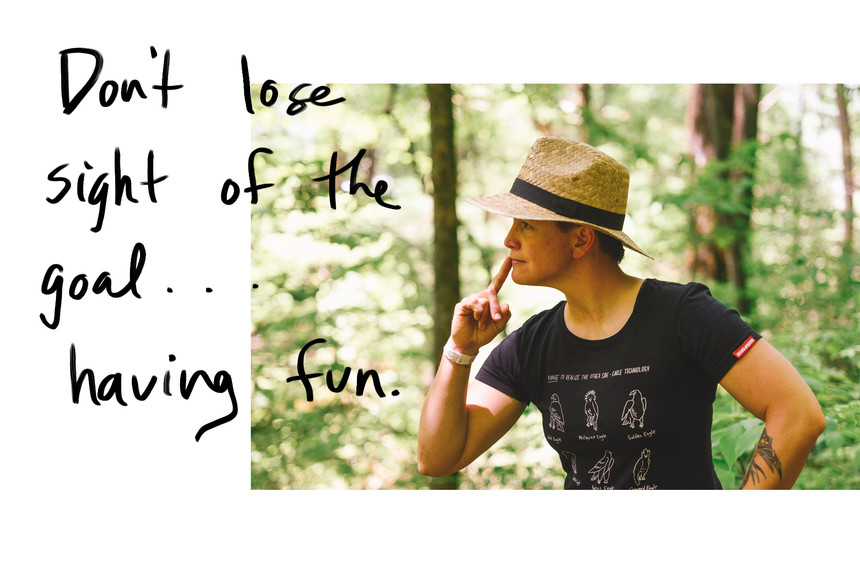
Shifting Gears: Inclusion in Biking Starts with Simple Mechanics
Story by Katie LozancichWalking through a pocket of dense trees at the Reeb Bike Ranch, Sara Jarrell and I are immersed in a sea of green. From my perspective the foliage surrounding us melds together, but Jarrell sees the forest differently.
At one point she suddenly stops. Our conversation pauses when she abruptly crouches down and waves me over. “Look at this,” she says excitedly. At first I see only the overgrown ferns, but on closer inspection there is a cluster of small flowers.
The Tar Heel proceeds to excitedly tell me the flower’s name, “They’re Jack-in-the-Pulpits.” She even adds the detail of precisely when they bloom. “Usually around March,” she says.
I had seen that attentive gaze before - the one that spotted the tiny hidden flower amidst a sea of green.
Days prior to our walk, we rode on nearby singletrack with a group of 11 women. On that ride, her attention was fixated not on the flora, but on the suspension of one of the rider’s bikes.
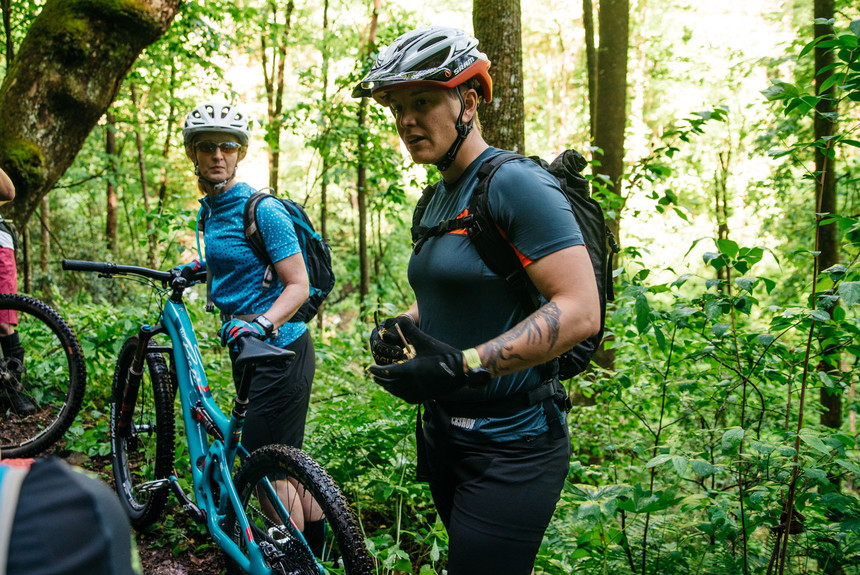
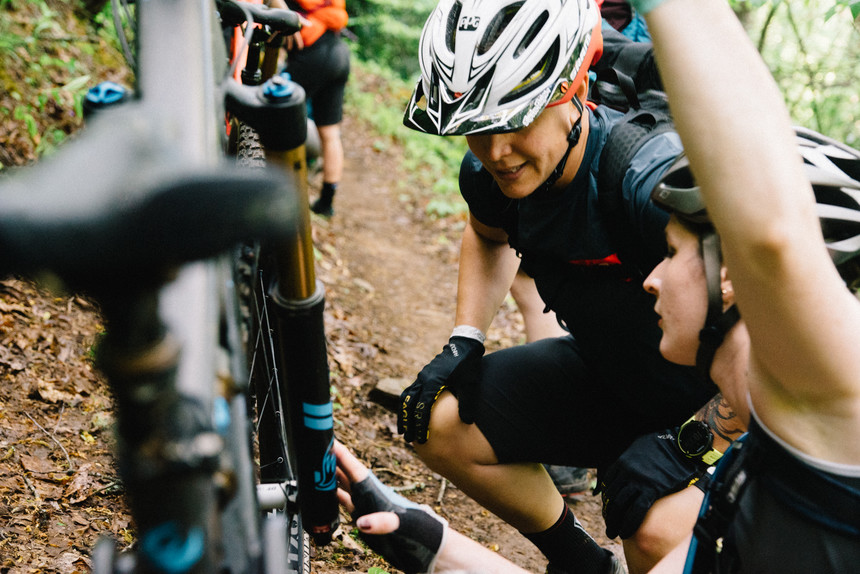
When it comes making mountain biking more inclusive, Jarrell wants to do it holistically. Addressing not only the riding but the technical side as well.
Like a virtuoso at a recital, her hands instinctively move across the front suspension dials. She makes a subtle adjustment and asks the rider to test the changes. After a few moments of pedaling, the rider is beaming.
While Jarrell’s adjustments made a noticeable difference on the bike, she wasn’t just acting as a trailside mechanic. As the women’s program coordinator for SRAM, she’s here at Roam Bike Festival East—an all women’s mountain biking festival—to be a teacher. It is just one of the many hats she has worn in her 16 years in the cycling industry.
Teacher and event curator are her most recent professions, but Jarrell is most known for her finesse as a mechanic.
Having wrenched bikes for Paralympians and taught at the highest level at SRAM’s Technical University, Jarrell now draws on her bank of invaluable knowledge to break down barriers.
Leading a clinic like this one is all in a day’s work. Whether it is here in Brevard, North Carolina, the Whistler Crankworx mountain biking festival, or a different cycling event across the country, Jarrell’s underlying goal never wavers: to build up and encourage the female mountain biking community.
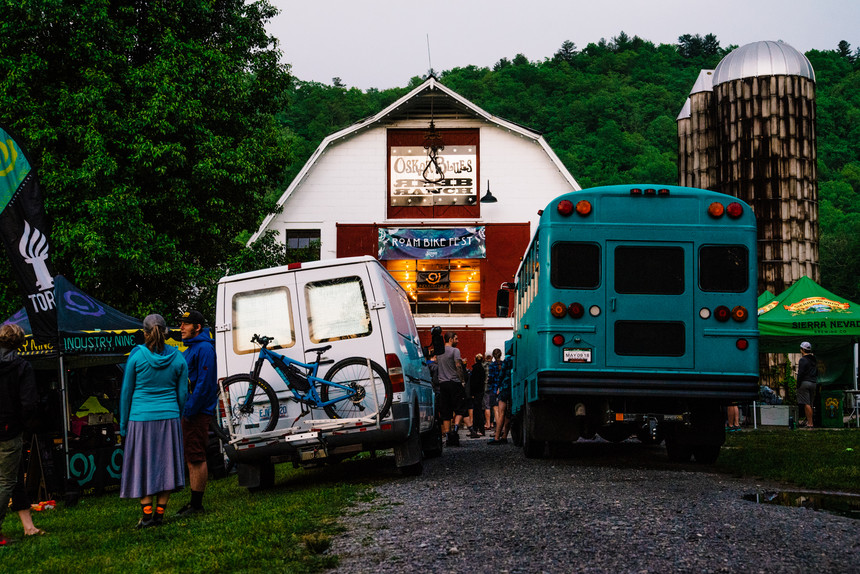
Roam Fest East brought over 200 women to Reeb Bike Ranch to explore the local riding scene in Brevard, North Carolina. It’s events like these that Jarrell often offers her clinics at.
“Out of all the female clinics we do, I get the most positive feedback about our technical clinics. People are hungry for the information,” Jarrell says to me. “If you think about it, anyone can go out a ride a bike, but not everyone understands the basic mechanics. If you equip them with even just the basics—changing a tire or setting up suspension—you’re giving them the confidence to go out and explore.”
Sara’s Background
“I always thought she would grow up to be a lawyer,” Sara’s mother, Marcia Jarrell, tells me laughing. “As a child she would ask you to do something and if you said no, fifteen minutes later she would come back with a different rendition of what she asked. She never gave up very easily.”
Her mother and sister both describe her as always being naturally inquisitive. As a child, you could usually find her nestled away reading in an apple tree.
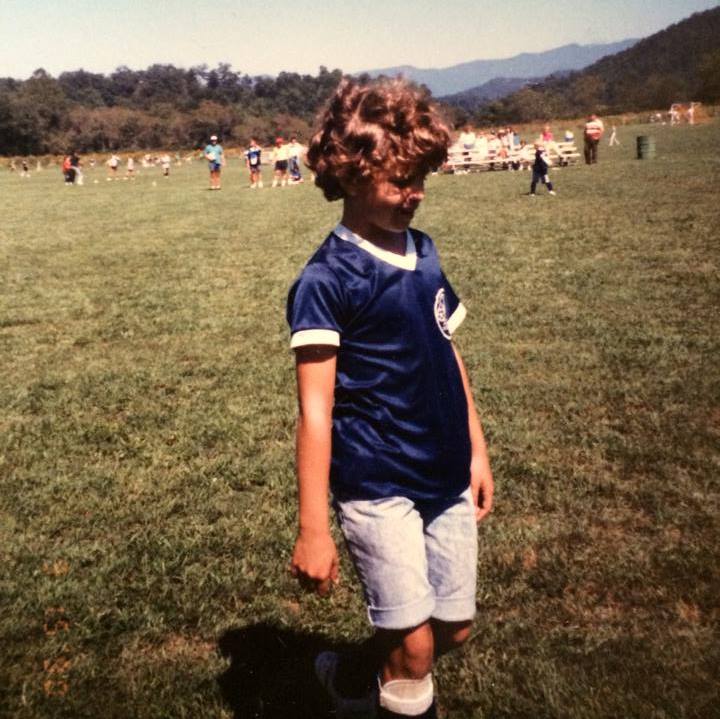

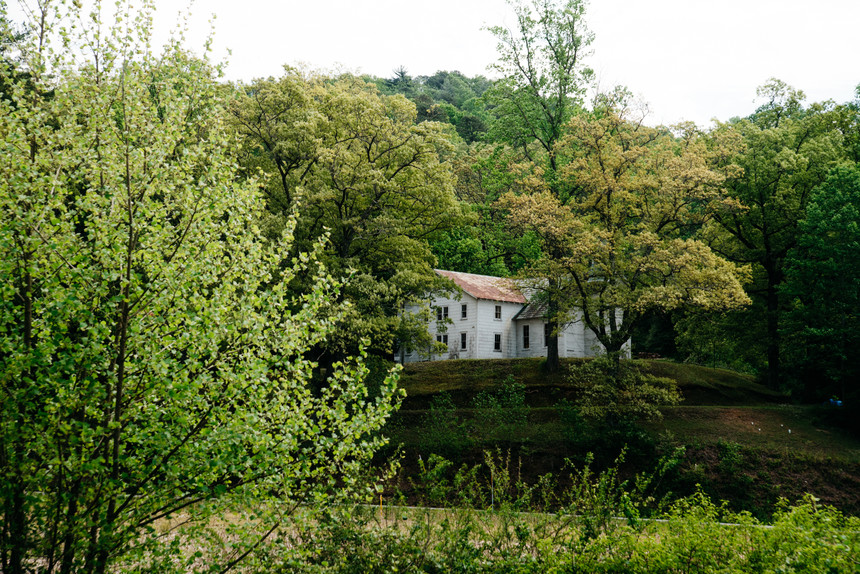
Ever since she was a kid, biking has always been a source of freedom for Jarrell. This meant getting lost deep in the woods of Western North Carolina.
Her childhood was spent in Cullowhee, a tiny mountain town in western North Carolina. There wasn’t much to do—no movie theaters or bowling alleys—so kids quickly learned how to create their own fun. For Jarrell, that meant riding their bikes. A lot.
“We lived near a college, so my friends and I would bike up to the campus and send it off the staircases,” Jarrell laughs. “Basically do all the stuff that would cause the campus police to chase you off.”
Undeniably determined, Jarrell eventually channeled her ambition into soccer. A natural athlete, she quickly excelled, to the point that coaches from all over North Carolina would come to watch her play. She was poised to compete on a collegiate level until two serious knee injuries derailed that dream.
These injuries would permanently end her career on the soccer field, but allowed for cycling to become an even bigger part of her life. Her passion grew beyond transportation or recreation, and Jarrell fell in love with racing.
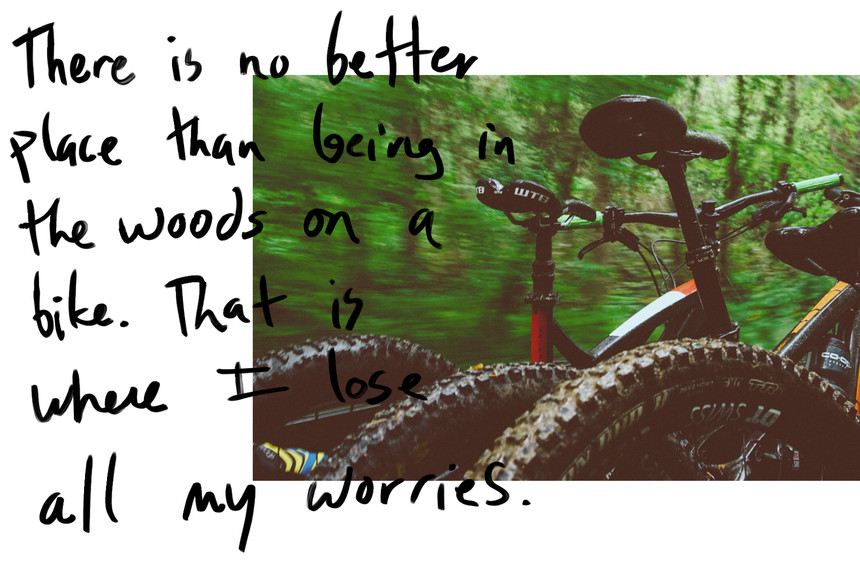
“I started out with XC then dabbled in some downhill, dual slalom, and four cross—and I was never fast enough to be a pro but just loved it,” Jarrell explains. This love would grow to be more than just a passion but an integral part of her life.
Throughout high school and college, Jarrell pursued a career within the culinary industry to support herself. Unable to find fulfillment as a sous chef, she decided to refocus her attention on the things that made her happy. And she knew what she loved most...biking.
Becoming A Mechanic
At the age of 21, Jarrell set her sights on becoming a bicycle mechanic because she had always loved tinkering with her gear. She decided that having no prior technical experience would not be a roadblock.
Most importantly, she had the drive, passion, and belief that she could work up to the skills it would take to realize her dream.
Deciding to relocate to Oakland with her girlfriend at the time, Jarrell applied to open positions at bike shops. One craigslist job posting proved fruitful, and she got the job after an in-person interview.
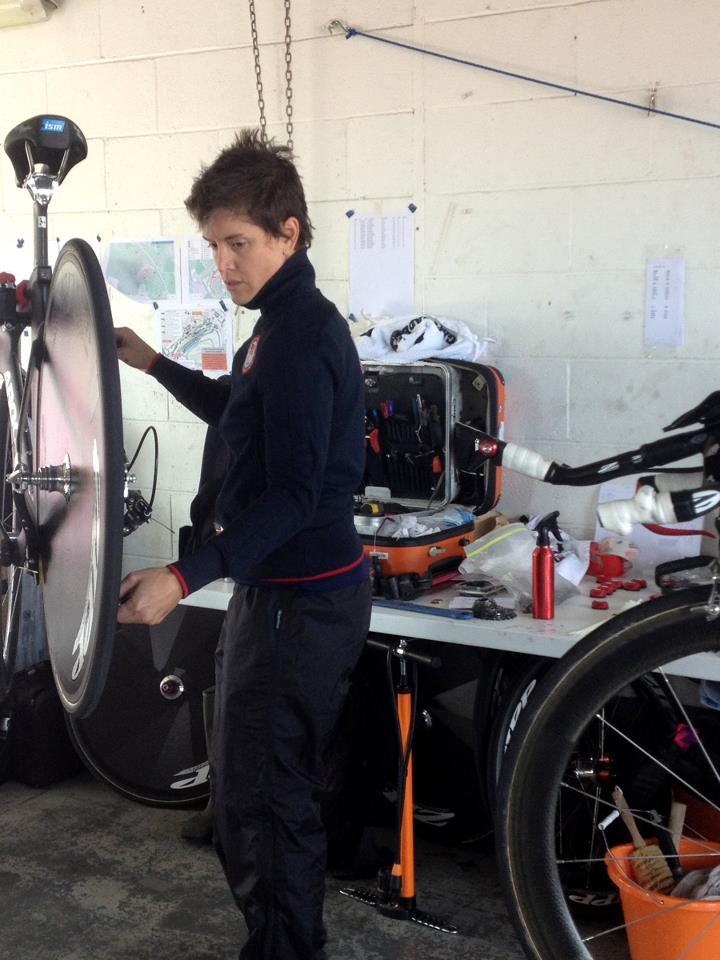
Jarrell got to the level of expertise she’s at today because someone was willing to be patient with her. Now she uses the same approach to encourage others in her field.
What appeared to be the first step in her path unraveled quickly when she arrived to the shop for her first day of work. Looking at her schedule she saw she wasn’t slotted for a single mechanic shift, instead they placed her on the sales floor. She was devastated.
Boldly, she quit.
This terrifying move would pay off three weeks later. Her phone rang, and it was the shop. “We could use your help,” they asked. This time when she came into work, it was as their new mechanic.
“Starting out in the bike industry you get told what to do by a lot of men, when I met Sara it was breath of fresh air,” says professional racer and SRAM ambassador Caroline Washam, who is Jarrell’s assistant for our North Carolina clinic. “It’s so badass, in the five years I’ve known her she’s taught so many women such important skills, and they’ll get to carry that knowledge with them.”
By being one of the few elite female mechanics, Jarrell represents a disappearing anomaly within the industry. Compared to today the paradigm is shifting. When she first started wrenching she was the only female mechanic she knew.
That was until she attended Barnett Bicycle Institute for some advanced technical training. To her surprise, her teacher was a woman.
“Meeting Jenny Gadbois and having her be my instructor, it opened my eyes to the fact that this could be more than just a job for me,” Jarrell said. “It showed me that there were women out there doing this at a high level and that was something I could aspire to.”
Women’s Program Coordinator Role
At the start of the clinic, Washam and Jarrell ensure every rider has the proper suspension set up before we even get pedaling.
This means having all the women stand on their pedals to bottom out the o-ring on their forks and shocks, indicating their sag. When the O-ring moves from their weight, it marks a distance on the stanchions. This distance serves as an important measurement, one that you’d ideally want at 30% of total travel. If it isn't quite there, Jarrell and Washam help with making the necessary adjustments.
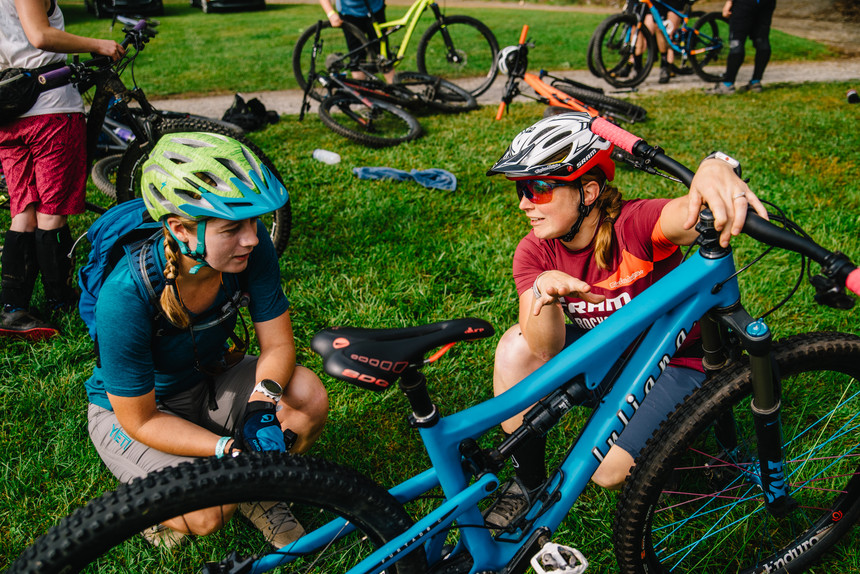
Caroline Washam teaches a clinic participant the intricacies of her suspension set up. As a SRAM ambassador, Washam is part of the team Jarrell curated to promote a greater female community in the sport.
Once the sag is properly set, clinic attendees have the ability to accurately control the rebound on their bike - manageable by the dials located on the tops of their shocks.
These are dials that riders are often too intimidated to experiment with, but when understood properly, can make a world of a difference in the experience of riding.
Rather than just explaining how to tinker with the knobs, Jarrell wants everyone to learn kinesthetically. Washam leads the group away from the ranch, and we’re riding until she finds a spot on the trail to pull us aside.
While we pause for a breath, Jarrell’s relaxed demeanor changes and she begins to scan the bikes.
As she works, she carries with her a level of grace that has been cultivated through years of dedication to her craft.
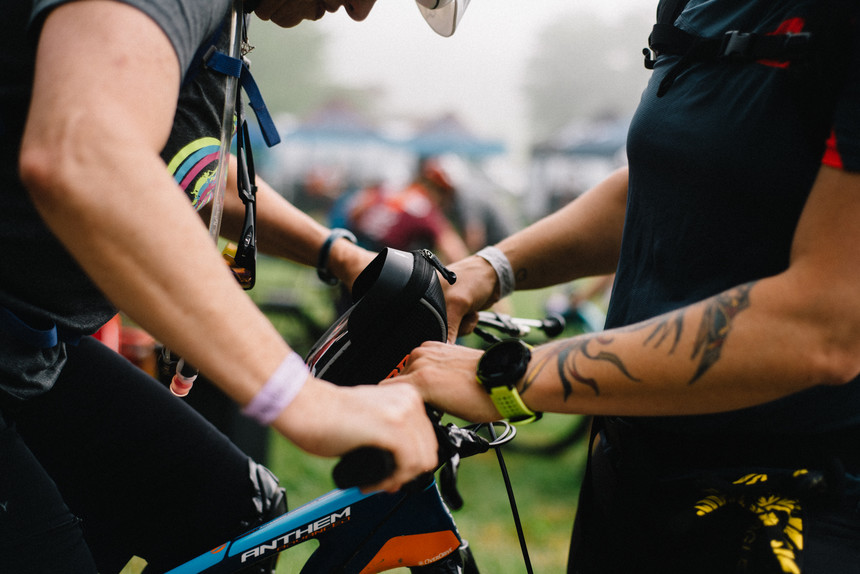
This clinic was a new approach to teaching for Jarrell. Her hope was that participants could actually feel the difference as they tinkered with the settings on their suspension
After that first job in Oakland, she returned to North Carolina. Coming full circle, she was hired at the shop where she bought her first bike. That opportunity would expose her to race mechanics, and her talent was noticed by the U.S. Para-Cycling team. To her excitement, she was invited to the 2012 London Paralympics.
“It was incredible, being a mechanic wrenching at that level was paramount. That’s the highest I could ever imagine,” she explains. “The amount of work and effort athletes at that level put into competing is incredible. To be part of the equation to help them get to the finish line—it was an honor.”
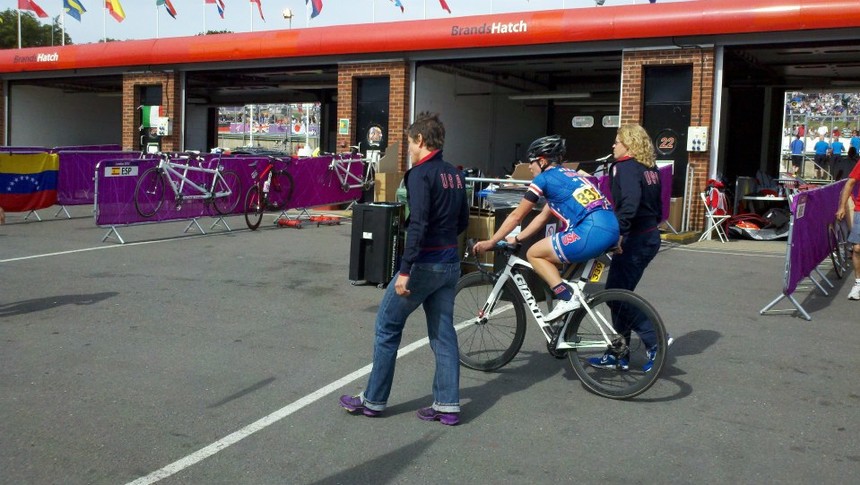
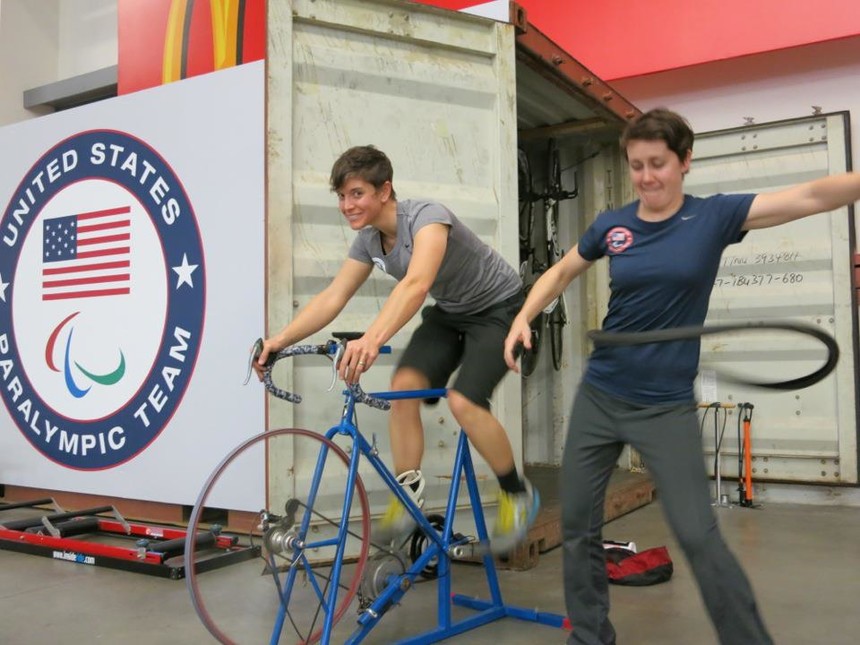
Wrenching for the Paralympic cycling team was a dream come true for Jarrell. She thrived working under the pressure of assisting these elite athletes to the finish line.
Traveling with the Para-Cycling team had her living a nomadic life; when the games were finished she found herself in a state of complete freedom.
Now seemed like the best time for a change. SRAM was hiring for their technical university (STU), and Jarrell decided to transition her path into education. She would become STU’s first female lead instructor, training mechanics from all over North and South America.
University teaching required a certain level of perfectionism. There were no cutting corners; one had to teach in line with all the technical documents, which brought a degree of professionalism to her skill set.
“It was a fun experience, I think there was a lot of shock on the first day when I would walk into a classroom completely full of guys and proceed to teach them three hours of suspension theory,” she laughed. Her biggest takeaway was learning a new joy of hers: sharing her knowledge.
Her prowess only grew the longer she was at SRAM. After leading the university as their head instructor, she got pulled into yet another direction: engineering. Her new role was not designing products, but using her knowledge to test and refine them.
Throughout her career, no matter what position she held, Jarrell was always advocating for women in the sport long before she had an official title to do it.

Despite her very busy work schedule, riding will always be a top priority for Jarrell.
“A few years before the women’s position existed, Sara created a Women’s STU,” explains Elayna Caldwell, SRAM’s mountain bike brand director who spearheaded the role within the company, “For the event, she reached out to me for support—all I did was get the budget—but it was her idea to bring together female product managers and brand ambassadors across the industry.”
The end result was a hugely successful riding and technical clinic, the kind of initiatives SRAM wanted to start owning moving forward as a brand.
When SRAM’s management finally approved the creation of such a role, it became obvious to pull from internal candidates. Having seen Jarrell take initiative first hand, Caldwell knew that she would thrive given the challenge. Now as she officially takes the reins, she continues to build on SRAM’s longstanding commitment to make the sport more inclusive.
“SRAM has always been at the forefront of being very supportive of women in cycling, we sponsor more women athletes than most brands in the industry,” Jarrell explained. This support isn’t isolated to athletics. SRAM wants to see more women break boundaries on the technical side as well.
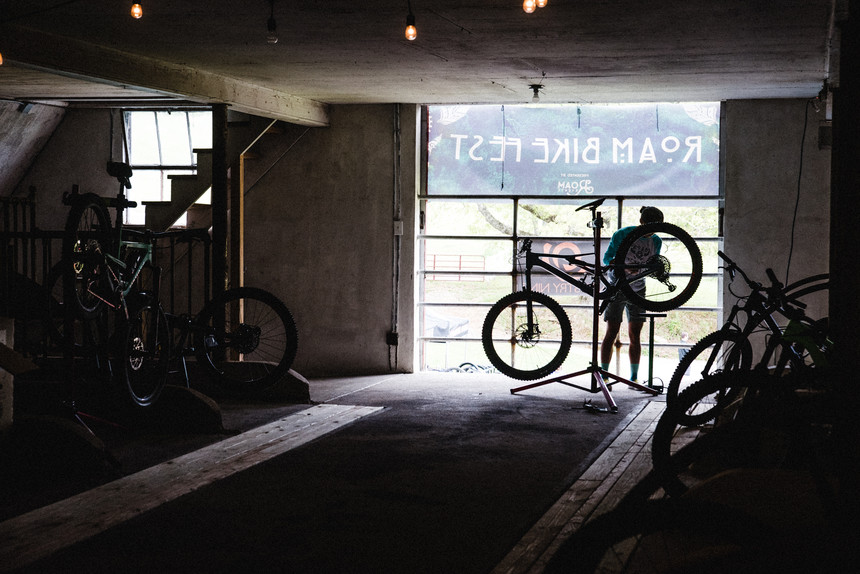
SRAM doesn’t limit female community to just riding, they hope to see it embraced into the technical side of the industry as well.
“QBP (the industry’s largest business supplier) and SRAM founded a women’s mechanics scholarship four years ago, the program has grown since its infancy,” she explained. The first year they had four recipients, now they have two classes for 16 eager ladies who want to learn. And the momentum is looking like it will only continue.
Moving Forward
The clinic is wrapping up. Washam begins to descend and some of the riders follow her back to the ranch. As I linger to gather my gear I notice one of the attendees who approaches Jarrell. “Thank you,” she says glowingly.
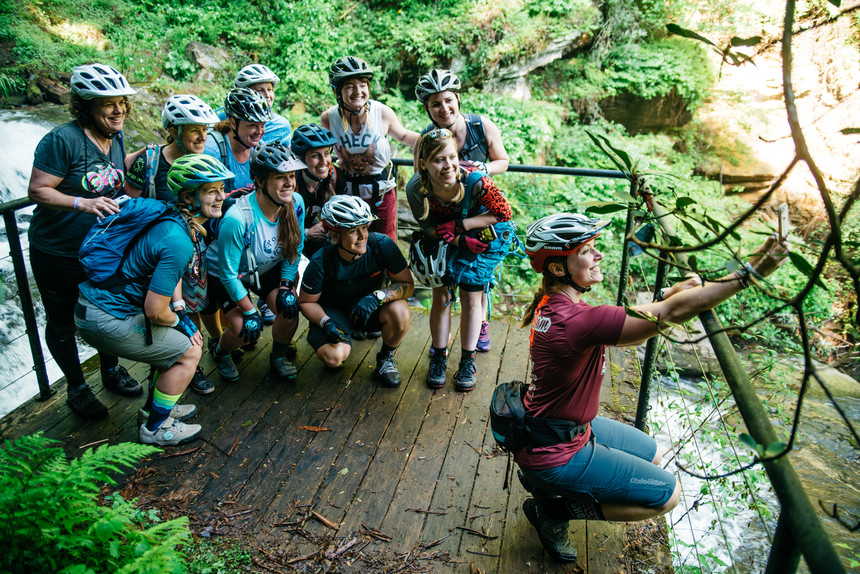
The group celebrates with a mid-ride selfie. The clinics have been a huge success at events like Roam Fest, in which women are incredibly eager to learn.
The woman had attended one of her clinics before and is elated to see Jarrell again.
Interactions of this nature are common for her. “Quite honestly though, in five years it would be great if that role doesn’t need to exist” she laughs. Yes, that’s correct, she just wished for her role to become obsolete.
This isn’t because she’s trying to find an excuse to ride her bike more. She reassures me that despite her busy schedule riding is still an utmost priority. It is because eventually female community in this sport shouldn’t need to be addressed.
The hope is for female community to be normal.
“There are so many women on bikes, and there’s no need to put a focus on creating community because it would already be there,” she explains but there’s still a lot of work to do and it doesn’t stop with gender.
“We have a long way to go as far as diversity—that’s the future where cycling needs to go.”
For now Jarrell is very much employed, and very busy. But, I’m keeping an eye on her future plans, and I’m eager to see what’s next.
